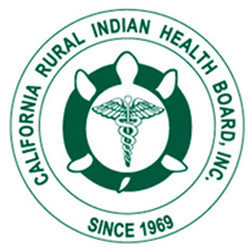The best thermometer, how do you find the one for you? iProven’s assortment of thermometers is vast, but fear not. We have created a true masterlist of our thermometers to help you pick the right one. Age is a big decider when choosing a thermometer. Depending on who’s temperature you want to measure, you might need a different measuring method and thermometer.
Jump to:
What’s the best thermometer for
What's the best thermometer for babies?
Measuring rectally is the recommended way for newborns up to 6 months. Rectal temperature is the most accurate and the closest to the actual body temperature. Since any fever in a newborn is a reason to worry, it is best to keep track of their temperature with utmost care. The best rectal thermometer for newborns is our DTR-1221A, a digital stick thermometer with a soft and flexible tip. It measures temperature in just 10 seconds.
For a quick check, a forehead thermometer is ideal. But follow it up with a rectal measurement if you are worried or the forehead thermometer shows an elevated temperature.
For babies older than 6 months, an ear measurement is a great option as well. It’s more accurate than a forehead measurement but might be difficult if your baby wiggles around a lot. Avoid measuring ear temp when your baby is younger than 6 months, as it might hurt them.
Get yourself a forehead and ear thermometer like our DMT-511, (also available on Amazon) which has a silent mode. Perfect for measuring your little one’s temp while they are asleep. This thermometer can measure the temperature of objects and liquid as well. Check the temp of your baby’s bottle, pram, or bathwater with the press of a button.
When do you need to call a doctor?
Any temperature above 97 Fahrenheit (°F) or 36.1 Celsius (°C) and under 100.4°F (38°C) is considered a normal body temperature.
For a baby younger than 3 months, always call your doctor when their temperature is 100.4°F (38°C) or higher.
If your baby is between 3 and 6 months old you should call a doctor when their fever reaches 102°F (38.9°C) or they seem sick with a fever between 100.4°F (38°C) and 102°F (38.9°C).
If your baby is 6 to 24 months old contact a doctor when their temperature is higher than 102°F (38.9°C) and does not decrease after a day. Also contact your doctor if they show other signs or symptoms like a cold, a cough or diarrhea.
What's the best thermometer for kids?
Measuring rectally is the most accurate method, but for kids it might be annoying. Till the age of 4 an ear measurement is the most accurate substitute. At the age of 4 and older they will be able to sit still long enough for a more accurate oral measurement. Our best oral thermometer for kids is the DTR-1221A, which you can use rectally or orally. Never use the same thermometer for both methods. Get two thermometers and label them if you want to take oral and rectal measurements.
The DTR-1221A is a fast thermometer with an easily understandable fever indicator with smileys. Show your kid the smileys and tell them what they mean: a smile for a healthy temp, a frown for elevation, and a sad face for fever. This way it’s easy to explain to them what their temperature means.
Want to measure their temp without a fuss? Get our TMT-215, our best kids thermometer, available in green and grey. It has not two, but three modes! Measure forehead, ear, and object temperature with one thermometer. Use the forehead mode for a quick check and the ear mode as a closer to true body temperature comparison. The object mode is perfect for measuring the temp of your kid’s food, bathwater, or room.
When do you need to call a doctor?
Contact a doctor when your kid’s temperature is higher than 102°F (38.9°C) and does not decrease after a day. Also contact your doctor if they show other signs or symptoms like a cold, a cough or diarrhea.
What's the best thermometer for adults?
The same thermometers we named for kids will work for adults as well. For adults, oral measurements are the most common method. This method is reliable thanks to the heat pockets underneath the tongue. Our best oral thermometer for adults is the DTR-1385. This thermometer takes slightly more time to measure than the aforementioned DTR-1221A. The extra measurement time gives you an even more accurate result.
A forehead thermometer is perfect for a quick and easy measurement. It’s non-invasive, but your forehead temperature fluctuates a bit more than ear temp. Getting yourself a device that can measure with both methods is a great idea.
Need a fast dual-mode thermometer that’s great for adults? Check out our best forehead and ear thermometer: the DMT-489, available in black and white! This faithfully accurate thermometer has a color-changing screen and a beeping fever alarm to warn you of a heightened temperature.
When do you need to call a doctor?
Fever in adults is usually not a cause for concern, but it’s a good call to contact a doctor if your temperature reaches 103°F (39.4°C) and above. Seek immediate medical attention if your fever comes with any of the following symptoms:
- Severe headache
- Abnormal skin rash, especially if the rash gets worse rapidly
- Abnormal sensitivity to light
- A stiff neck and pain when you bend your head forward
- Mental confusion
- Unrelenting vomiting
- Chest pain or difficulty breathing
- Abdominal pain or pain while urinating
- Convulsions or seizures
What's the best thermometer for seniors?
For seniors an oral thermometer might be confusing to use. This is why we recommend forehead and ear measurements. Use a forehead measurement for an easy check and an ear measurement for better accuracy.
Our best thermometer for seniors is the DMT-316. This forehead and ear thermometer has big buttons and an easy to read screen with backlight. The thermometer beeps when detecting a fever. The screen changes color corresponding to the measured temperature. Green for a healthy temp, orange for elevated temp, and red for fever. The DMT-316 is the most easy to read thermometer in our assortment.
When do you need to call a doctor?
Dehydration is a real problem for seniors. If the fever comes with diarrhea and/or vomiting, contact a doctor and make sure you stay hydrated. Seek immediate medical help if the fever is higher than 103°F or if the fever comes with any of the following symptoms:
What's the best thermometer for groups?
Need to measure temperature at the entrance of your office, school or any other open place?
We recommend a non-contact forehead thermometer that is built to measure the temp of a larger group of people. No need to clean the thermometer in between measurements and you can measure from a safe distance. Check out our best non-contact gun thermometers, the NCT-336 or NCT-978.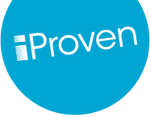

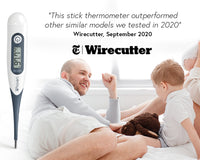
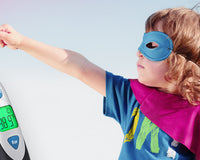
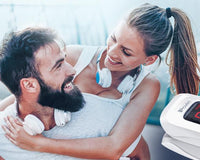
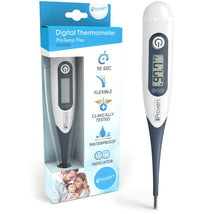
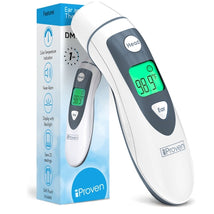

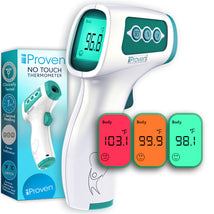
![iProven DMT-77 No-Touch Forehead Thermometer for Adults, Kids, Babies [Superior Accuracy, Upgraded Fever Alarm, Quiet Vibration Alerts] Digital Infrared Baby Thermometer with Ear Mode, Hypothermia Alarm](http://iproven.com/cdn/shop/files/AMI_DMT-77_image1_V3.3_MP_1_214x.jpg?v=1690531003)










